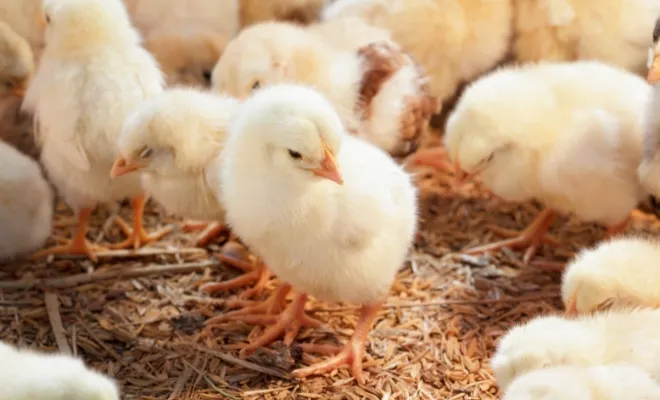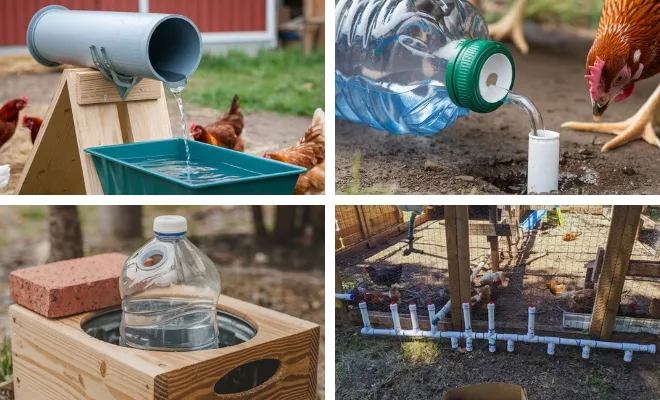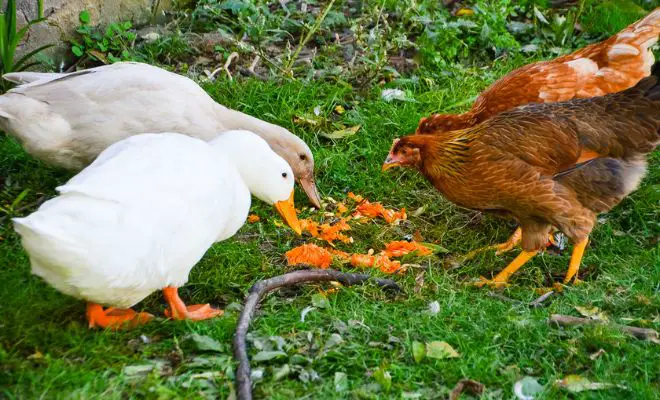31 Must-Have Chicken Supplies You Should Keep!

When it comes to raising chickens, having the right supplies is essential. From their coop to their food and water, there are certain items you should have.
But what are the must-have chicken supplies? The chicken supply list includes a sturdy chicken coop with proper feeding and watering equipment. It’s also important to have bedding material for cleanliness and comfort, along with tools for maintaining their living space. And don’t forget to offer them their entertainment part!
With the proper equipment, chickens get a safe and comfortable environment to thrive in. By investing in these essential supplies, you set yourself up for success! So, let’s see the list of supplies you can offer your poultries!
Table of Contents
List of 31 Must-Have Chicken Supplies: What Do You Need to Raise Them?
Before you bring home a coop full of feathered friends, it’s important to know all the supplies they need. But what are those? Let’s share the list of 31 essentials –
1. Chicken Coop Supplies
A sturdy, weatherproof, well-ventilated coop is critical! It keeps your flock safe from predators and protected from harsh weather conditions.
Provide 4-5 square feet of interior coop space per full-sized chicken. The chicken coop should contain roosting bars 1-3 feet off the ground for sleeping, one 12×12 inch nesting box per 4 hens, and adequate cross-ventilation.
2. Nesting Boxes
Hens need a safe, secluded space to lay their eggs. So, chicken egg supplies are another priority!
Provide one 12×12 inch nesting box per 4-5 hens. Line the bottom with 4-6 inches of bedding material like wood shavings or straw. Position nesting boxes 2-3 feet off the ground in a dimly lit corner of the coop for privacy.
Proper nesting boxes encourage hens to lay eggs in a designated area rather than on the coop floor.
3. Coop Refresher
Litter/bedding additives like sweet PDZ, diatomaceous earth, or zeolite help control odors and moisture levels inside the coop. Sprinkle a coop refresher over the bedding weekly or as needed to maintain a dry, fresh-smelling environment.
4. Ideal Bedding
Cover the entire floor of the coop with a 4-6 inch layer of absorbent litter like pine shavings, straw, or hemp bedding for chicken. This traps moisture from droppings and makes for easier cleaning. A deep litter allows droppings to compost down into a nutrient-rich fertilizer over time.
Clean out wet, soiled areas regularly and do a full bedding change every 6 months.
5. Chicken Feed
Proper nutrition is vital for health and egg production. Chicks up to 6 weeks old need a high 18-20% protein chick starter crumble. From 6 weeks until they start laying around 16-24 weeks, pullets require a 16-18% protein grower feed.
Once hens begin laying eggs, switch to a 16% protein layer feed or fermented feed for optimal nutrition.
6. Chicken Feeder
Use an enclosed feeder like a trough, tube, or hopper that keeps feed contained and off the ground.
Open feeders allow the feed to get soiled by droppings and attract pests. Mount feeders at the hens’ back height to prevent debris but still be easily accessible.
7. Chicken Waterer
Provide at least 1 pint of fresh, clean water per chicken daily in a covered waterer. You need it to keep water from getting soiled quickly. Durable waterers like inverted bucket designs work well. Clean and refill daily.
8. Feeders and Waterers
Having quality, properly designed feeders and waterers is essential! Why? It’s for providing chickens with a steady supply of fresh feed and clean water. Enclosed designs keep contents protected.
9. Water Need
In addition to the main waterers, keep spare water containers in the coop and run areas. It’s in case the primary supply gets spilled or soiled. Ensuring chickens never go without fresh drinking water is vital.
10. Apple Cider Vinegar
Adding 1 tablespoon of apple cider vinegar per gallon of drinking water provides many benefits. It acidifies the crop and gut to boost nutrient absorption and prevent bacterial issues like sour crops. The “mother” culture in unfiltered vinegar adds beneficial enzymes and probiotics.
11. Brooder
For the first 4-6 weeks, baby chicks need a warm, secure brooder setup. It’s essentially a heated area blocked off for safe rearing.
The brooder should have a heat lamp positioned to create a 95°F area. It gradually reduced by 5°F weekly as chicks feather out. Provide bedding, feeders, and waterers.
12. Chicken Run
An enclosed outdoor run or pen attached to the coop provides vital space for –
- Exercise
- Sunlight
- Grazing, and
- Natural behaviors.
Outfit runs with predator-proof fencing buried into the ground and protective overhead netting or roofing. Allow at least 10 square feet of run space per chicken. I would say add a run roof for a more safe zone for chickens.
13. Coop Heater
When temperatures drop below freezing, supplemental heat is needed inside the coop to prevent frostbite. Electric flat panels or radiant heaters work well, as do heated perches/roosts. A heat lamp can also provide localized warmth.
14. Dust Baths
Chickens need a dry, loose litter area for dust bathing. It helps them groom feathers and control pests.
Create a 2-3 foot diameter, 6-inch deep dust bath using mason sand, dirt, or diatomaceous earth. Rake and refresh it regularly.
15. Diatomaceous Earth
This fine white powder is made from crushed fossils.
When dusted on coop surfaces, in cracks/crevices, and lightly over birds, diatomaceous earth kills mites, lice, and other pests naturally through desiccation. It can also help eliminate internal worms when a little is ingested by hens.
16. Power Source
Access to electricity enables the use of amenities like –
- Lighting
- Heated roosts
- Automatic coop doors
- Plugin waterers and more.
Also, solar power with battery backups can work well if grid access is limited.
17. Heat Lamp
A heat lamp is essential for providing supplemental warmth. It’s especially true when raising chicks in a brooder.
Position the lamp on one side so chicks can self-regulate their heat. Heat lamps can also provide localized coop heating.
18. Automatic Door Opener
An automatic chicken coop door opener synced to timers or light sensors. It allows the pop door to open at dawn and close at dusk without human intervention. Plus, it secures your flock safely on a routine schedule.
19. Chicken Grit
Insoluble grit made from granite or crushed egg/oyster shells around 1/8-1/4 inch in size is crucial. It’s for helping a chicken’s gizzard grind up feed for proper digestion. Offer grit-free choice in a separate feeder.
20. Roost/Perch
Horizontal roosting bars positioned 2-4 feet off the coop floor give chickens a safe, comfortable place to roost at night. Make roosts 2-4 inches wide and allow 8-10 inches per bird to prevent crowding.
21. Secure Fencing
To contain chickens in runs and exclude predators, use hardwire, electric netting, or hardwire cloth fencing buried at least 1 foot into the ground and slanted outwards. Overhead fencing/netting prevents aerial raids.
22. Predator Deterrents
Reinforce secure fencing and locked coops with additional deterrents like
- Motion sensor lights/alarms
- Loud radio/ultrasonic devices
- Predator decoys/effigies, and
- Livestock guardian animals.
23. Pest Control Plants
Planting herbs and flowers like –
- Lavender
- Mint
- Marigolds
- Garlic around the coop area.
All these things deter flies, rodents, and other pests through natural smells and oils. The plants are safe for chickens too.
24. Treats/Supplements
Offer healthy treats to supplement feed, like mealworms, greens, berries, and limited scratch grains for foraging. Cal/Phos grits, crushed oyster shells, and vitamin supplements support strong eggshell production.
25. Feeding Tool
Use a long-handled “tossing” rake or hooked tool to scatter scratches, treats, and greens. It’s while keeping your hands safely away from pecking beaks. This encourages natural foraging behaviors.
26. Chick Grit
While chicks develop their digestive system, provide chick-sized soluble grit around 1/8 inch in diameter rather than larger laying hen grit sizes. The smaller size is easier for chicks to digest.
27. Chicken Toys/Xylophone
Environmental enrichment toys prevent boredom and redirect pecking behaviors. A chicken xylophone, treat balls, or simple cabbages hung for pecking provide stimulation.
28. Chicken Ladder/Swing
Slanted ladder ramps assist chickens in getting up to different levels and nest boxes in the coop. Chicken swings give them another outlet for activity and play.
29. Chicken Mirrors
Mounting mirrors at chickens’ eye level gives the illusion of other birds. It also redirects feather pecking while providing a distraction.
30. Compost Area
A designated enclosed compost bin is a great idea! It allows you to transform the nitrogen-rich coop waste and bedding into nutrient-dense fertilizer for gardens.
31. Wintertime Light
In winter, when there’s less sunlight, some hens may not lay eggs.
To help, you can add extra light for a few more hours each day. This encourages them to start laying again. Use a timer to turn the light on and off. Make sure the light is far from anything that can catch fire and that the chickens can’t touch it.
See the video to enlighten yourself with chicken supplies!
FAQs
Check out the following questions to get more facts about daily chicken supplies.
Q. What do chickens need a lot of?
Chickens need a lot of fresh water and a complete layer of feed. You give it for optimal health and egg production.
Q. What do you need for 5 chickens?
For 5 chickens, you’ll need a coop with 25 sq ft space. Plus, 5-6 nesting boxes, feeders, waterers, and an outdoor run area are important.
Q. Is it OK to feed chickens once a day?
No, it’s best to provide layer hens access to fresh feed and clean water at all times. Avoid giving food once per day.
Q. How to make a cheap chicken pen?
Use inexpensive materials like portable dog pens, hardware cloths, pallets, and tarps. It helps to create a secure, shaded outdoor chicken pen.
Q. How many chickens should I start with?
For beginners, it’s recommended to start with 3-5 hens as a manageable first flock size.
Conclusion
You’ve got to take good care of your poultries with ideal supplies. Make sure they’ve got a sturdy coop, with cozy nesting boxes and plenty of food and water dishes. Don’t forget about bedding to keep them comfortable and dust bathing areas for them to get clean. Protect them from any sneaky predators too.
If you’ve got all the right supplies, those chickens will be living their best lives. They’ll provide you with loads of fresh eggs and will become a good companion!






